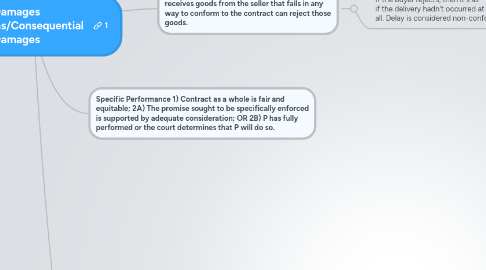
1. Specific Performance 1) Contract as a whole is fair and equitable; 2A) The promise sought to be specifically enforced is supported by adequate consideration; OR 2B) P has fully performed or the court determines that P will do so.
2. Evidence of a Stipulated Damages Term. This is enforceable if when viewed from the time of K formation: (1) damages would be uncertain in amount or difficult to prove; (2) the amount stipulated in the stipulated damages provision is a reasonable approximation from the loss that the parties would be suffered from the breach; (3) the term was not intended to be a penalty.
2.1. If no Stipulated Damages Clause
2.1.1. General Damages - the goal of an award of damages is to use money to put the plaintiff in the position s/he would have been if both parties had fully performed. General damages compensate the plaintiff for injuries that naturally and necessarily flow from the breach. This the loss that anyone who was the victim of the breach would have suffered in the sense that it does not depend on the plaintiff's own particular circumstances. Loss in Value - Cost Avoided Loss in value is the amount D must pay P for any loss P experiences as a result of shortcomings in D's performance. Cost avoided applies when D gets credit for any savings P experiences if D's material breach has the effect relieving P of any part of P's own duty to perform.
2.1.1.1. Owner's "Loss in Value" Contractor Situations
2.1.1.1.1. Complete or correct by substitute transactions (default) - what it would cost the Owner to have another contractor complete/correct the defective performance. *If breach is in bad faith this is the method court will likely choose.
2.1.1.1.2. Diminution in value (alternate) - the difference between the value the Owner's land would have been had if the Contractor had performed as promised and the value the land actually has even with the Contractor's defective performance.
2.1.1.2. Consequential/Incidental Damages - any damages that the plaintiff suffers that are not addressed by general damages.
2.1.1.2.1. Foreseeability: D is only liable for such losses as s/he, at the time the K was made, foresaw or should reasonably have foreseen as a probable result of his/her breach.
2.1.1.2.2. Avoidable Consequences Rule: A P who fails to act reasonably to avoid consequences of a breach cannot recover for those losses if it could have reasonably been avoided. Corollary rule: P can recover for reasonable costs of trying to avoid losses even if those attempts are not successful.
2.1.1.2.3. §353 Loss Due to Emotional Disturbance: Recovery for emotional disturbance will be excluded unless the breach also caused bodily harm or if serious emotional disturbance was a particularly likely result.
2.1.1.2.4. Certainty requirement elements: P can recover for a component of his/her claimed loss only if: (1) It is more likely than not that the loss exists and was caused by Defendant's breach; and (2) The trier of fact is provided with a basis other than the speculation from which it can reasonably estimate the amount (measure in dollars) of that loss.
2.1.1.3. Losing Contracts ("when there is a negative expectancy in the K")
2.1.1.3.1. §349 Reliance As an alternative to the measure of damages, the injured party has a right to damages based on his reliance interestminus any loss that the party in breach can prove with reasonable certainty the amount of loss the injured party would have suffered had the contract been performed.
2.1.1.3.2. US v Algernon Blair If P partially performed, and then the D breaches, as an alternative to §349 Reliance, the P can rescind the K.
2.1.1.4. Unjust Enrichment Partial performance, but P would not be able to recover against the other party on the contract under the contract.
2.1.1.5. Off settings of claims (in an assignment situation). If there are multiple contracts and some of them are assigned and some are not the court will treat the claims as if there were a single contract unless notice of the breach comes after the initial breach.
2.1.1.6. Determining the market value for a repudiation is a reasonable period after the buyer learns of the repudiation.
2.1.1.6.1. If there is hope that the other party may retract, then the reasonable period of time is determined by (1) the likelihood of retraction; (2) time necessary to arrange a substitute transaction; (3) time to arrange financing to supplement transaction.
2.1.1.7. If governed by UCC
2.1.1.7.1. UCC 2-708(1) Loss in value is the benefit P would have received had the D not breached and Cost Avoided is the market value of the bread.
2.1.1.7.2. Lost Volume Dealer applies when (1) supply greatly exceeds demand and (2) items are sold at a uniform/consistent price. A party can recover lost profit and the cost to produce and cost to market one of the subject items.
